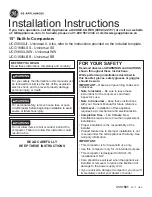
TROUBLESHOOTING
Troubleshooting - 70
Symptom:
Possible Cause:
Engine emits white smoke.
Low engine temperature.
Faulty head gasket.
Water in combustion chamber.
Excessive fuel consumption.
Plugged or restricted air filters or hose.
Dirty or faulty fuel injectors.
Engine uses excessive oil.
Check for leaks.
Incorrect oil viscosity.
Plugged or restricted air filters and or hose.
Worn rings or cylinder walls.
Worn or faulty valves.
Electrical
Anytime there is an electrical issue, first check to ensure the LED light for the Power input (bottom right
corner) of the TCM is turned on when the key switch is in the Off position. If the light is not on:
a. Check the battery disconnect switch to ensure it is turned on.
b. If the battery disconnect switch was already turned on, the TCM may be in ‘Sleep’ mode. Turn the
battery disconnect switch off for 10 seconds and then back on to ‘Wake’ the TCM.
c. Check the 15 amp fuse in slot #10 of the rear fuse panel. Replace this fuse, if necessary.
Next, turn the key switch to the On position and check to see if any of the other lights turn on. If no other
lights turn on, check the 5 amp fuse in slot #9 of the rear fuse panel. If any other lights turn on, you can
start troubleshooting the rest of the TCM functions.
Symptom:
Possible Cause:
Battery does not charge.
Loose or corroded connections.
Broken or loose wire in charge system.
Blown fuse or fuse link in charge system.
Defective battery.
Loose alternator belt.
Defective alternator.
Lights do not activate.
Blown fuse.
Blown light bulb.
Broken wire.
Defective light switch.
Glow plugs do not activate.
Blown fuse.
Broken wire.
Faulty glow plugs.
PTO does not engage.
Blown fuse.
Faulty seat switch. (Operator must be in seat).
Faulty PTO switch.
PTO belt failure.
Clutch air gap out of adjustment.
Faulty clutch.
Engine (Continued)







































